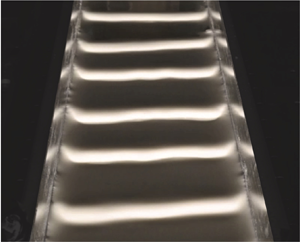Article contents
Shear-thickening suspensions down inclines: from Kapitza to Oobleck waves
Published online by Cambridge University Press: 22 March 2023
Abstract

We investigate experimentally and theoretically the stability of a shear-thickening suspension flowing down an inclined plane. In a previous paper (Darbois Texier et al., Commun. Phys., vol. 3, 2020), we have shown that for particle volume fractions  $\phi$ above the discontinuous shear-thickening fraction
$\phi$ above the discontinuous shear-thickening fraction  $\phi _{DST}$, long surface waves grow spontaneously at a flow Reynolds number much below 1. This motivated a simplified analysis based on a purely inertialess mechanism, called the ‘Oobleck waves’ mechanism, which couples the negatively sloped rheology of the suspension with the free-surface deflection and captures well the experimental instability threshold and the wave speed, for
$\phi _{DST}$, long surface waves grow spontaneously at a flow Reynolds number much below 1. This motivated a simplified analysis based on a purely inertialess mechanism, called the ‘Oobleck waves’ mechanism, which couples the negatively sloped rheology of the suspension with the free-surface deflection and captures well the experimental instability threshold and the wave speed, for  $\phi >\phi _{DST}$. However, neglecting inertia does not allow us to describe the inertial Kapitza regime observed for
$\phi >\phi _{DST}$. However, neglecting inertia does not allow us to describe the inertial Kapitza regime observed for  $\phi <\phi _{DST}$, nor does it allow us to discriminate between Oobleck waves and other inertial instabilities expected above
$\phi <\phi _{DST}$, nor does it allow us to discriminate between Oobleck waves and other inertial instabilities expected above  $\phi _{DST}$. This paper fills this gap by extending our previous analysis, based on a depth-averaged approach and the Wyart–Cates constitutive shear-thickening rheology, to account for inertia. The extended analysis recovers quantitatively the experimental instability threshold in the Kapitza regime, below
$\phi _{DST}$. This paper fills this gap by extending our previous analysis, based on a depth-averaged approach and the Wyart–Cates constitutive shear-thickening rheology, to account for inertia. The extended analysis recovers quantitatively the experimental instability threshold in the Kapitza regime, below  $\phi _{DST}$, and in the Oobleck waves regime, above
$\phi _{DST}$, and in the Oobleck waves regime, above  $\phi _{DST}$. By providing additional measurements of the wave growth rate and investigating theoretically the effect of a strain delay in the rheology, it also confirms that the instability observed above
$\phi _{DST}$. By providing additional measurements of the wave growth rate and investigating theoretically the effect of a strain delay in the rheology, it also confirms that the instability observed above  $\phi _{DST}$ stems from the non-inertial Oobleck wave mechanism, which is specific to free-surface flows and dominates modes of inertial origin. These results emphasize the variety of instability mechanisms for shear-thickening suspensions and might be relevant to free-surface flows of other complex fluids displaying velocity-weakening rheology.
$\phi _{DST}$ stems from the non-inertial Oobleck wave mechanism, which is specific to free-surface flows and dominates modes of inertial origin. These results emphasize the variety of instability mechanisms for shear-thickening suspensions and might be relevant to free-surface flows of other complex fluids displaying velocity-weakening rheology.
JFM classification
Information
- Type
- JFM Papers
- Information
- Copyright
- © The Author(s), 2023. Published by Cambridge University Press
References
REFERENCES
- 8
- Cited by


